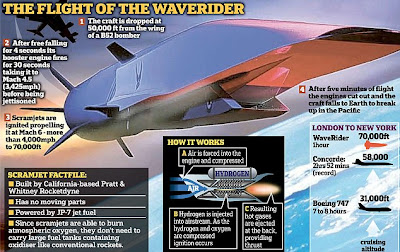US Air Force test of its hypersonic X-51A Waverider vehicle, an unmanned aircraft designed to fly six times the speed of sound, ended in catastrophe.
The hypersonic test vehicle lost control and was destroyed before reaching it's 4,600 mph goal.
Controllers identified a fault in one of the X-51A Waverider's control fins shortly after its rocket booster had fired, the service said in a written statement.
About 16 seconds into the flight, the aircraft "was not able to maintain control due to the faulty control fin and was lost," the service said.
The Air Force had hoped the craft would be able to reach speeds of up to 4,600 mph. The service said it will release details of the failed test in a few weeks, after researchers are able to analyze the data.
The US Air Force hasn’t disclosed the cost of the WaveRider program, but Globalsecurity.org, a website that tracks military spending, says the project has cost $250-300 million since it began in 2004.
After this loss during testing, only one aircraft remains, and Air Force officials have not decided when or if it will fly.
Controllers identified a fault in one of the X-51A Waverider's control fins shortly after its rocket booster had fired, the service said in a written statement.
About 16 seconds into the flight, the aircraft "was not able to maintain control due to the faulty control fin and was lost," the service said.
The Air Force had hoped the craft would be able to reach speeds of up to 4,600 mph. The service said it will release details of the failed test in a few weeks, after researchers are able to analyze the data.
The US Air Force hasn’t disclosed the cost of the WaveRider program, but Globalsecurity.org, a website that tracks military spending, says the project has cost $250-300 million since it began in 2004.
After this loss during testing, only one aircraft remains, and Air Force officials have not decided when or if it will fly.
Background
At just 25 feet long and only a few inches in diameter, the Waverider is a far cry from an aircraft that can carry people anywhere. But the technology one day could send people or troops across the world in just minutes.
Hypersonic travel, meaning speeds of Mach 5 (3,800 miles per hour) and above, has been a focus of the military as it looks to perfect a technology that can become the new stealth. The Pentagon says that countries are becoming wiser to US stealth technology and it is increasingly becoming a less effective tool.
Hypersonic flight does away with stealth because its speeds allow for greater flexibility and control for missions that are not possible with current jet technology.
But in the commercial world, it can mean flights are so quick a flight attendant hardly would have time to serve drinks and a meal, and there would be no more groggy feeling after those transcontinental flights.
The technology is significant because a hypersonic aircraft breaths oxygen, like a regular jet engine, but reaches speeds five times that of commercial aircraft. To get similar results, the only other option is rocket power.
"You would have to have bulky fuel tanks, nozzles and plumbing and that makes rocket power more heavy and more expensive," says Dora Musielak, an adjunct professor of physics at the University of Texas at Arlington.








No comments:
Post a Comment